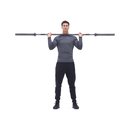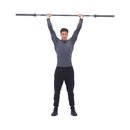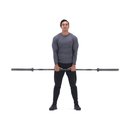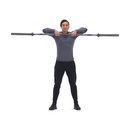"Shoulders maketh the man." No doubt you've heard this maxim uttered dozens of times, but have you ever actually pondered why it rings true? A set of broad shoulders isn't the only marker of a man's masculinity, but it is a powerful one. Dating back to ancient times, representations of great conquerors, warriors, kings, and gods have always come complete with wide, strong shoulders. Military uniforms have often featured padding and epaulets to make the delts appear wider and more massive.
Even if we flash forward to modern times and scan the surveys in women's magazines like Cosmopolitan to find which physical attribute draws female attention first, wide shoulders are always at the top of the list. You can have bulging arms, thick pecs, and even a six-pack row of abdominals, but if they're all framed in by narrow, stooped shoulders, good luck with the ladies. You're gonna need it.
Assuming you fully appreciate the importance of rugged delts for a manly body, it's time to start planning how to go about constructing your own pair. Though the deltoids are a complex muscle group with many different functions, luckily they are not so complicated to train. Further, they are a fairly responsive area for most trainers, especially when worked though their complete ranges of motion with proper form. With just three basic shoulder exercises that have stood the test of time for millions of weight trainers and athletes, you can be well on your way to shocking your shoulders into expansive growth.
Shoulder Form and Function
Before delving into a training prescription for the shoulders, it would serve us well to quickly look at what the individual parts of the muscle do in the human body. The deltoids derive their name from the Greek delta, or triangle, as the muscle resembles a triangle in shape. It is a muscle with three distinct 'heads' or segments. The anterior, or front head, flexes and inwardly rotates the arm. The front delts play a major assisting role in chest training, and even receive some degree of stimulation from biceps and triceps exercises like barbell curls and dips. Because of all the ancillary work they receive, front delts are often an overdeveloped item on many physiques. Over time, this can even lead to posture problems, as the person tends to adopt a 'slumped forward' stance. The medial, or side head, abducts the arm, meaning that it brings the arms out and away from the midline of the body. The side heads are only activated to a significant level when trained using specific isolation movements. Finally, the posterior, or rear head, extends the arm and produces external rotation. The rear delts are very much involved in back training movements such as chins and rows. Now that we have a better understanding of what our shoulders do, let's get into how to train them right!
Exercise 1. Side Lateral Raise
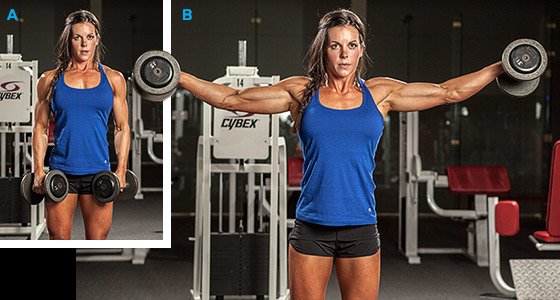
{{caption}}
The most critical component to creating broader shoulders is increasing their width. To accomplish this, we selectively target the medial deltoid head. The larger the cross-sectional area of the side deltoids, the wider and rounder your shoulders will appear. Of course, clavicle width plays the most important role in how wide your shoulder ultimately can become. In the recent Sydney Games, you may have noticed that nearly all swimmers possessed clavicles on the upper end on the genetic spectrum for width.
Few of the swimmers had massive deltoid development by physique magazine standards, but having such a wide skeletal framework made what size they did have seem that much more impressive. You may have wide clavicles, narrow, or something in between. Regardless of the foundation you were dealt, anyone can increase their width to a meaningful extent by building up the mass of the side delts. There is only one exercise we know of that isolates the medial heads, and that is the side raise, also known as the side lateral raise.
Side raises can be performed with a cable attachment or specialized machines, but the most widely-practiced version of this exercise is with a plain old pair of iron dumbells. As outdated and obsolete as some high-tech snobs may consider free weights, they are still with us despite all the advanced machine designs proliferating our gyms and health clubs. Simply put, barbells and dumbells aren't going anywhere because they work. The additional effort and coordination it takes to balance free weights not only make them more difficult to master, but also forces the muscles to work harder. This struggle translates into a forced adaptation of the muscle fibers. In other words, they have no choice but to become larger and stronger in the face of the stress.
Begin with your feet planted firmly at shoulder width. Hold the dumbells in front of you with your thumbs pointing forward. With a slight bend in the elbows, raise the 'bells up to just above your shoulder joints. You may either complete the movement with your palms parallel to the floor, or instead choose to tip the thumbs downward in what is frequently described as a 'pouring water out of two pitchers' motion. Many trainers feel a more pronounced contraction in the side delts when this extra motion is added. Slowly lower the dumbells back into the start position under strict control. The negative, or lowering, portion of the rep is just as important as the actual lifting. Never merely drop the weight back down.
Exercise 2. Upright Barbell Row
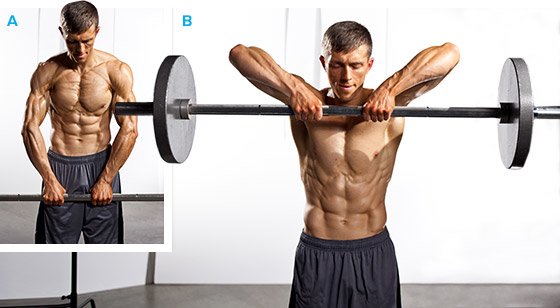
{{caption}}
Upright rows are often included in training programs for the back. This is because when a wide grip is utilized, the majority of the stress is directed to the muscle fibers of the trapezius. With a narrow grip, upright rows become an excellent movement that targets all three heads of the deltoids.
Place your hands no more than six inches apart on the bar. Pull the bar to just underneath your chin, allowing the elbows to flare out as wide as possible. You may see some people pulling higher, for example to the eyes, but this is a greater range of motion than is necessary.
Exercise 3. Standing Military Press

{{caption}}
This exercise is so named due to its regular inclusion in physical conditioning programs for several branches of the Armed Forces. No movement is more basic for the shoulders. The military press is to the shoulders as the bench press is to the chest, and the squat is to the thighs. It allows for the maximum amount of resistance to be lifted, which translates into optimal results. All three heads of the deltoids work hard in the press. Such a marker of upper body strength is the military press that for decades it and not the bench press were what other trainers meant when they asked, "How much can you press?"
There are numerous machines with which to press, and you will often see trainers performing their presses seated with a back support, using either a barbell or dumbells. The standing press is far more difficult to perform, and thusly superior in terms of producing results. Unless you are already addicted to wearing a lifting belt, going beltless on this will even help you build a stronger lumbar spine musculature as the lower back muscles have to struggle to stabilize the upper body.
Either take the bar from a squat rack, or clean it to your shoulders. Your grip should be such that your forearms are perpendicular to the ground at the halfway point. For most of you, this will have your hands placed about two inches on each side wider than your shoulders. Press up smoothly to lockout, taking care not to use any hip thrust or anything but pure shoulder power to press the barbell. Feel the shoulders working every inch of the rep.
That's the time-proven trio of shoulder shockers that will be your ticket to bigger and broader shoulders. If you're about to buy any suits or jackets, you might just want to hold off for a while. Those delts of yours will soon be entering a growth phase, and there's no telling how big they just might get!




